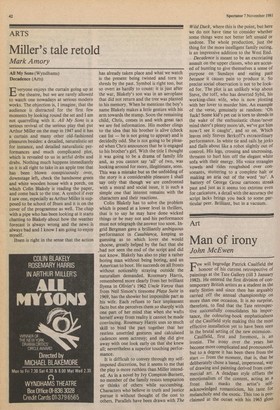Art
Man of irony
John McEwen
Elewwill begrudge Patrick Caulfield the honour of his current retrospective of paintings at the Tate Gallery (till 3 January 1982). He entered the first division of contemporary British artists as a student in the early Sixties and since then has arguably carried off the annual championship on more than one occasion. It is no surprise, therefore, to find that the Tate retrospective successfully consolidates his importance, the colouring-book emphaticalness of the Caulfield style making this the most effective installation yet to have been seen in the brutal setting of the new extension.
Caulfield, first and foremost, is an ironist. The irony over the years has become more complicated and pronounced, but to a degree it has been there from the start — from the moment, that is, that he deliberately chose a banal, impersonal, way of drawing and painting derived from commercial art. A deadpan style offsets the emotionalism of the content, acting as a front that masks the artist's selfacknowledged romanticism, his taste for melancholy and the exotic. This too is proclaimed at the outset with his 1963 gloss paint on board version of Delacroix's 'Greece Expiring on the Ruins of Missolonghi', the painting he chose as a transcription subject at the Royal College of Art. Early still-lives of jewels, daggers and ruins can clearly be seen as a spin-off from this theme, succeeded in the Seventies by contemporary subjects in which romanticism is implied by a general scenario rather than symbolic objects. Melancholy tends to get the upper hand. There is a preoccupation with the night-time and there are at least two memorable post-scriptions: the Tate's forlorn, smoke-blue rendering of a deserted restaurant, 'After Lunch'; and the empty in-tray, the gleaming formica desk-top of 'After Work'. It would seem that things began to get a bit too obvious for the artist's taste, that he was letting his feelings go too unchecked. Day-time romanticism returns in the most recent pictures, pleasure getting the better of regret, elaboration of simplicity. Reference is piled on reference, irony on irony. Caulfield has admired the poetry of Jules Laforgue since student days and made a memorable set of illustrations for the poems in a Petersburg Press publication of 1973. In his clear and informative catalogue introduction Marco Livingstone quotes Michael Collie on Laforgue: 'the habit of irony which is his defence against the world is also his defence against sentimentality'; and finds this equally descriptive of Caulfield.
Needless to say irony in a Caulfield painting is not just a matter of deadpan graphic style. It is equally expressed by the subject and, particularly in the most recent work, the growing number of painterly styles used: graphic, photographic, impressionist, trompe-l'oeil. Painting today is more selfconscious of tradition than it has ever been, and by making at once an irony and a game of it Caulfield has extended his own metaphorical and technical range. This tendency can lead to confusion ('Town and Country') or tricksiness (a weakness for graphic pepper-pots with photographic metal screws) and it is said in the introduction that he now intends to paint more simply again, but nevertheless it was a Logical evolution and it released his wit and humour. However, as if this was not enough, there is another side altogether to the appreciation of these pictures. The forthrightness of their commercial method and often architectural subject-matter conceals both the subtlety of their investigation of colour, and form in the abstract and, from 1969, the refinement of their exploration of light — natural and artificial, sometimes in conjunction.
To achieve such multiplicity of suggestion is the hallmark of artistic quality; and Marco Livingstone and the Walker Art Gallery, Liverpool, are particularly to be congratulated for organising this show now. Special reference is made in the catalogue to the influence on Caulfield of Cris, Leger, Magritte and the Americans Davis and Hopper. If that is the table then he is certainly good for a seat — and it is Still comparatively early days. Caulfield is no less notable as a printmaker. The retrospective of his prints at Waddington Galleries (4 and 31 Cork Street, 4-27 November) is therefore an abnormally vital adjunct to the main exhibition at the Tate.



























































 Previous page
Previous page